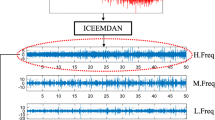Abstract
The recent increase in machining productivity is closely related to longer tool life and good surface quality. In the present study, an experimental technique is proposed to evaluate the performance of a cemented carbide inset during the machining of AISI D3 steel. The aim of this technique is to find a relationship between the vibratory state of the cutting tool and the corresponding wear during machining in order to detect the beginning of the transition period to excessive wear. A spectral indicator named spectral center of gravity, SCG, is proposed to highlight the three phases of tool wear using the spectra of the accelerations measured. Very promising results are obtained which can be used to underpin an industrial monitoring system capable of detecting the onset of transition to excessive wear and alerting the user of the end of the tool’s life. The purpose of this study is to review the vibration analysis techniques and to explore their contributions, advantages and drawbacks in monitoring of tool wear.








Similar content being viewed by others
Abbreviations
- V c :
-
Cutting speed (m/min)
- f :
-
Feed rate (mm/rev)
- ap:
-
Depth of cut (mm)
- RMS:
-
Root mean square
- VB:
-
Flank wear (mm)
- R a :
-
Arithmetic average of absolute roughness (µm)
- R t :
-
Maximum height of the profile (µm)
- R z :
-
Average maximum height of the profile (µm)
- SCG:
-
Spectral center of gravity
- OL:
-
Overall level
- WMRA:
-
Wavelet multi-resolution analysis
- \(fs\) :
-
Sampling frequency
- L i :
-
Value of the autospectrum at the sampling frequency
- γ :
-
Rake angle (°)
- λ :
-
Inclination angle (°)
- χ r :
-
Major cutting edge angle (°)
References
D.E. Daimler, Sensor signals for tool-wear monitoring in metal cutting operation—a review of methods. Int. J. Mach. Tools Manuf 40, 1073–1098 (2000)
M.K. Babouri, N. Ouelaa, A. Djebala, Experimental study of tool life transition and wear monitoring in turning operation using a hybrid method based on wavelet multi-resolution analysis and empirical mode decomposition. Int. J. Adv. Manuf. Technol. 82, 2017–2028 (2016)
R. Suresh, S. Basavarajappa, G.L. Samuel, Some studies on hard turning of AISI 4340 steel using multilayer coated carbide tool. Measurement 45, 1872–1884 (2012)
A.K. Sahoo, B. Sahoo, Experimental investigations on machinability aspects in finish hard turning of AISI 4340 steel using uncoated and multilayer coated carbide inserts. Measurement 45, 2153–2165 (2012)
C. Xiaozhi, L. Beizhi, Acoustic emission method for tool condition monitoring based on wavelet analysis. Int. J. Adv. Manuf. Technol. 33, 968–976 (2007)
K. Jemielniak, O. Otman, Tool failure detection based on analysis of acoustic emission signals. J. Mater. Process. Technol. 76, 192–197 (1998)
L. Weighing, G. Xeiguo, T. Obikawa, T. Shirakashi, A method of recognizing tool-wear states based on a fast algorithm of wavelet transform. J. Mater. Process. Technol. 170, 374–380 (2005)
C.M. Cemal, I. Yahya, Detecting tool breakage in turning AISI 1050 steel using coated and uncoated cutting tools. J. Mater. Process. Technol. 159, 191–198 (2005)
I. Yahya, C.M. Cemal, Finite element analysis of cutting tools prior to fracture in hard turning operations. Mater. Des. 26, 105–112 (2005)
J.M. Zhou, M. Andersson, J.E. Stähl, A system for monitoring cutting tool spontaneous failure based on stress estimation. J. Mater. Process. Technol. 48, 231–237 (1995)
M.K. Babouri, N. Ouelaa, A. Djebala, Identification de l’évolution de l’usure d’un outil de tournage basée sur l’analyse des efforts de coupe et des vibrations. Revue Sci. Technol. Synthèse 24, 123–134 (2012)
M.K. Babouri, N. Ouelaa, A. Djebala, Temporal and frequential analysis of the tools wear evolution. Mechanika 20, 205–2012 (2014)
W. Rmili, A. Ouahabi, R. Serra, M. Kious, Tool wear monitoring in turning processes using vibratory analysis. Int. J. Acoust. Vib. 14, 4–11 (2009)
M. Kious, M. Boudraa, A. Ouahabi, R. Serra, Influence of machining cycle of horizontal milling on the quality of cutting force measurement for the cutting tool wear monitoring. Prod. Eng. Res. Dev. 2, 443–449 (2008)
Sandvik Coromant, Outils de coupe Sandvik Coromant, Tournage–Fraisage–Perçage–Alésage—Attachements (2009)
S. Khamel, N. Ouelaa, K. Bouacha, Analysis and prediction of tool wear, surface roughness and cutting forces in hard turning with CBN tool. J. Mech. Sci. Technol. 26, 3605–3616 (2012)
J. Krimphoff, S. Mcadams, S. Winsberg, Caractérisation du timbre des sons complexes. II. Analyses acoustiques et quantification psychophysique. J. Phys. IV(C5), 525–528 (1994)
M. Kenzari, Vibroacoustic diagnosis of gears defects: sound perception approach analysis. Master of Sciences Thesis, INSA of Lyon, France, 2009
R. Younes, N. Hamzaoui, N. Ouelaa, A. Djebala, A perceptual study of the evolution of gear defects. Appl. Acoust. 99, 60–67 (2015)
Acknowledgements
This work was completed in the Laboratory of Mechanics and Structures, University 8 May 1945, Guelma, Algeria. The authors would like to thank the Algerian Ministry of Higher Education and Scientific Research for granting financial support of the CNEPRU Research Project—LMS No.: J0301520130034 (University of 8 May 1945 Guelma).
Author information
Authors and Affiliations
Corresponding author
Rights and permissions
About this article
Cite this article
Babouri, M.K., Ouelaa, N., Djamaa, M.C. et al. Prediction of Tool Wear in the Turning Process Using the Spectral Center of Gravity. J Fail. Anal. and Preven. 17, 905–913 (2017). https://doi.org/10.1007/s11668-017-0319-y
Received:
Published:
Issue Date:
DOI: https://doi.org/10.1007/s11668-017-0319-y




